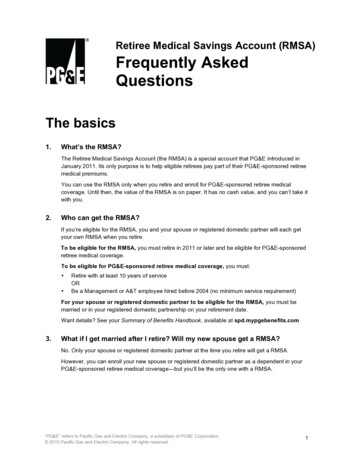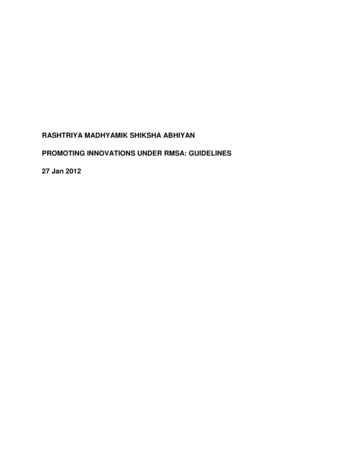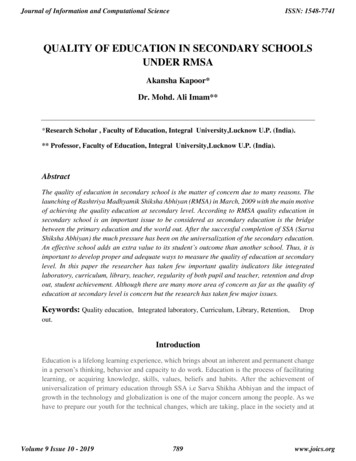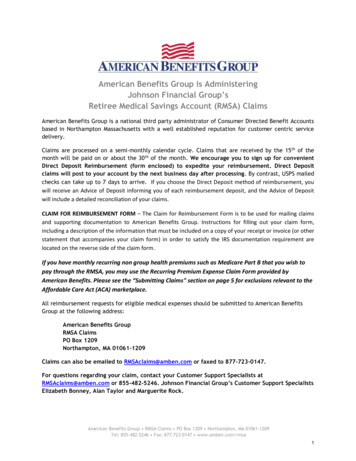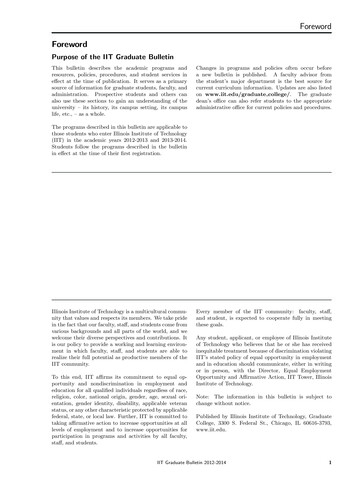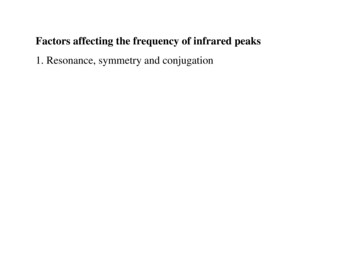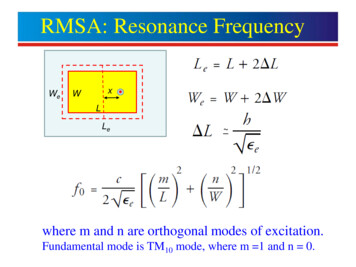
Transcription
RMSA: Resonance FrequencyWexWLLe where m and n are orthogonal modes of excitation.Fundamental mode is TM10 mode, where m 1 and n 0.
RMSA – Characterization
RMSA: Design EquationsSmaller or larger W can be taken thanthe W obtained from this expression.BW α W and Gain α WChoose feed-point x between L/6 to L/4.
RMSA: Design ExampleDesign a RMSA for Wi-Fi application (2.400 to 2.483 GHz)Chose Substrate: εr 2.32, h 0.16 cm and tan δ 0.001 3 x 1010 / ( 2 x 2.4415 x 109 x 1.66) 4.77 cm. W 4.7 cm is taken 2.23Le 3 x 1010 / ( 2 x 2.4415 x 109 x 2.23) cm 4.11 cmL Le – 2 L 4.11 – 2 x 0.16 / 2.23 3.9 cm
RMSA: Design Example – Simulation using IE3DL 3.9 cm, W 4.7 cm, x 0.7 cmεr 2.32, h 0.16 cm and tan δ 0.001Zin 54Ω at f 2.414 GHzBW for S11 -10 dB is from2.395 to 2.435 GHz 40 MHzDesigned f 2.4415 and Simulated f 2.414 GHz% error 1.1%. Also, BW is small.SOLUTION: Increase h and reduce L
Effect of Various Parameters on Performance of RMSAWeWxLLeL 3 cm and W 4 cmSubstrate parameters: εr 2.55, h 0.159 cm, and tan δ 0.001Probe diameter 0.12 cm for SMA connector.RMSA is analyzed using commercially available IE3D software.
Effect of Feed Point Location (x)For Infinite Ground PlaneWith increase in x, input impedance plot shifts righttowards higher impedance values.
Rectangular Microstrip Antenna (RMSA)YTopViewXWxLSideView rGround planehCo-axial feed
Effect of Width (W)With increase in W, aperture area, εe and fringing fields increase, hence frequencydecreases and input impedance plot shifts towards lower impedance values.BW α W and Gain α W
Effect of Thickness (h)BW α h/λ0As h increases, fringing fields and probe inductance increase,frequency decreases and input impedance plot shifts upward.However,to reduce surface waves
Effect of Probe DiameterAs probe diameter decreases, its inductance increases, soresonance frequency decreases and input impedancelocus moves upward to the inductive region.
Effect of Loss Tangent (tanδ )With increase in tan δ, dielectric losses increase, so inputimpedance locus moves left towards lower impedancevalue. BW increases but efficiency and gain decrease.
Effect of Dielectric Constant (εr)With decrease in εr, both L and W increase, which increases fringingfields and aperture area, hence both BW and Gain increase.
RMSA – Pattern for Different εr (TM10 mode)With increase in εr ,size of the antennadecreases for sameresonance frequency.Hence, gaindecreases andHPBW increases.
RMSA – Pattern for Different εr (TM30 mode)For TM30 mode,Le 3 λ0 / (2 εe )For εr 2.32, Le λ0So, two radiating slotswill be at a distance ofλ0 yielding gratinglobe in E-plane.
RMSA – Dual Polarization (TM10 and TM01 modes)( - - - ) theoretical, (——) measuredL 10.1 cm and W 7.9 cmMeasured resonance frequenciesOrthogonal Feeds at:are 712 MHz and 913 MHz forx 3.8 cm and y 2.9 cmtwo orthogonal modesSubstrate Parameters:εr 4.3, h 0.16 cm, tanδ 0.02
Effect of Finite Ground PlaneFinite Ground Plane Size is taken asLg L 6h 6h and Wg W 6h 6h
MSA – BW Variation with h and f
Square MSA in Air – VSWR PlotSquare MSA on afinite ground plane.Low cost - Metallicplate suspended in airand fed by a co-axialfeed.BW for VSWR 2 is95 MHz at 1.8 GHz(% BW 5%)
Square MSA in Air – Radiation PatternRadiation Patternat 1.8 GHzF/B 15 dBCross Polar 20 dB
MSA – Suspended Configurations
CMSA: Resonance Frequencywhere Knm is the mth rootof the derivative of theBessel function of order nFor Fundamental TM11 Mode:f0 8.791 / [(a h/ εr) εe ] GHzwhere a and h are in cm and εe εrDesign Equation:a 8.791 / (f0 εe) - h / εrChoose feed-point x between 0.3a to 0.5a
RMSA: Resonance Frequency where m and n are orthogonal modes of excitation. Fundamental mode is TM 10 mode, where m 1 and n 0. L L e W e W x. RMSA -Characterization. RMSA: Design Equations Smaller or larger W can be taken than the W obtained from this expression. BW αW and Gain αW

